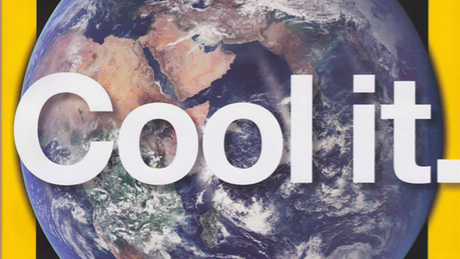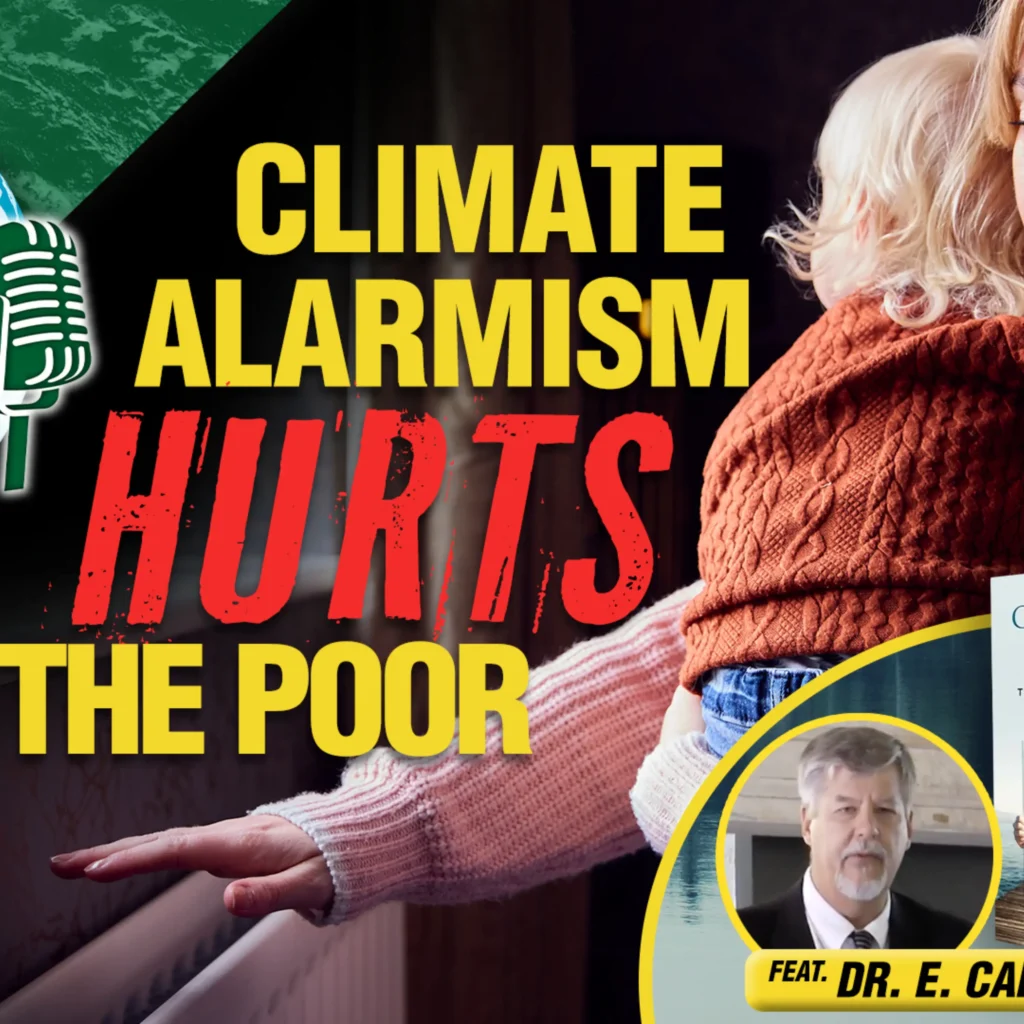The November 2015 edition of National Geographic is devoted to global warming. (See excerpts I’m addressing in PDF form.) A friend who tracks and writes about global warming also noticed this special “Climate Issue” of the magazine, and emailed me with a suggestion:
If it’s possible to do, we might compose a sophisticated response to the issue, carefully worded to avoid confrontation but simply to indicate that our research and experience through the years has tipped our scales in the opposite direction. My guess is that they would publish such a retort.
That’s a worthy endeavor, but I suspect my friend is wrong about National Geographic publishing such a response. That would be tantamount to admitting they were wrong to devote months of work to featuring transparent falsehoods in their magazine.
Interesting that they choose to title it “Cool It,” though. That’s the same as the title of Bjorn Lomborg’s 2007 book, which asks environmentalists to cool down their hot rhetoric about man-made global warming. Pity they didn’t read it. Here are some excerpts from Lomborg’s book: Lomborg, B. 2007. Cool It: The Skeptical Environmentalist’s Guide to Global Warming. New York, NY: Alfred A. Knopf.
Trade-offs, scarcity
“But whether we talk about the costs or not, someone still has to pay. Even if we don’t debate our priorities, we still end up prioritizing. Even if we end up doing some good, we might easily have done much better. If we are to embark on the potentially most costly global-policy program ever, we might first want to be sure it is the best use of our resources.” (132)
“But if we are to make comparisons across many different and disparate areas it is crucial that we maintain our objectivity, and the economic approach helps us to do so.” (134)
“Far from being amoral to compare costs and benefits, it is crucially moral to ask, How do we help the most? Can it really be moral to do anything less?” (135)
“But even though temperature rises may not be as devastating as people think, and even if there are other, cheap ways to deal with much of the temperature increase, is it still not also obvious that we want to cut CO2 emissions? Well, maybe. It really depends on how much good we can accomplish and at what cost.” (22)
“[I]t is obvious that there are many other and more pressing issues for the third world, such as almost four million people dying [annually] from malnutrition, three million from HIV/AIDS, 2.5 million from indoor and outdoor air pollution, more than two million from lack of micronutrients (iron, zinc, and vitamin A), and almost two million from lack of clean drinking water.” (42)
“…local surveys in that country [Tanzania] show the biggest concerns are the lack of capital to buy seeds, fertilizers, and pesticides; pests and animal diseases; costly education; high HIV-infection rates; malaria; and low-quality health services. I believe we have to dare to ask whether we help Tanzanians best by cutting CO2 which would make do difference to the glaciers, or through HIVB policies that would be cheaper, faster, and have much greater effect.” (57) [citing Ijumba, Mosha, and Lindsay, 2002; Richey, 2003; Soini, 2005:316; Vavrus, 2002]
“What we must come to terms with is that even though CO2 causes global warming, cutting CO2 simply doesn’t matter much for most of the world’s important issues. From polar bears to poverty, we can do immensely better with other policies.” (116)
“Changing national energy systems takes a long time and has huge costs.” (118)
“The fundamental economic problem with both Kyoto and its stricter follow-ups is that all macro economic models show that they are poor investments.” (119) [emphasis in original]
What we need instead is a “low-cost, long-term, viable solution to global warming.” (123)
“This is the real moral problem of the global-warming argument – it means well, but by almost expropriating the public agenda, trying to address the hardest problem, with the highest price tag and the least chance of success, it leaves little space, attention, and money for smarter and more realistic solutions.” (123)
“It is one – but only one – problem of many we will have to tackle through the twenty-first century.” (124)
In the peer-reviewed studies, [annual] global-warming damages run at about 1 percent of GDP and costs [to reduce CO2 emissions] at about 2 percent. It is important to say that you can’t just compare the costs of the two, because incurring the costs doesn’t avoid all the damage. But basically incurring a 2 percent cost for a 1 percent benefit is a bad deal, which explains why economic cost-benefit analyses recommend only moderate CO2 reductions. (137)
“All major peer-reviewed economic models agree that little emissions reductions is justified. A central conclusion from a meeting of all economic modelers was: ‘Current assessments determine that the ‘optimal’ policy calls for a relatively modest level of control of CO2.’ [Citing Nordhaus, 1998) In a review from 2006, the previous research was summarized: ‘These studies recommend that greenhouse-gas emissions be reduced below business-as-usual forecasts, but the reductions suggested have been modest.'” (37) [Citing Stern, 2006… so Stern was probably criticizing previous studies.]
Benefits exceed costs until 2400
“If we try to stabilize emissions, it turns out that for the first 170 years the costs are greater than the benefits. Even when the benefits catch up till the late 22nd century, there is still a payback time before the total benefits outweigh the total costs, around 2250. Thus, as one academic paper points out, ‘the costs associated with an emissions stabilization program are relatively large for current generations and continue to increase over the next 100 years. The first generation to actually benefit from the stabilization program is born early during the 24th century.'”[citing Kavuncu and Knabb, 2005, 369-383.] (37)
Lomborg on health effects of warmer temperatures
“Actually, the direct impact of climate change in 2050 will mean fewer dead, and not by a small amount. In total, about 1.4 million people will be saved each year, due to more than 1.7 million fewer deaths from cardiovascular diseases and 365,000 more deaths from respiratory disorders.” (38) [He assumes increased deaths from respiratory disorders? 1.4 million avoided deaths per year x 40 years (2010 to 2010) would be 56 million lives saved? He cites Bosello, Roson, and Tol, 2006, 582.]
“[L]ives saved will continue to outweigh extra deaths when counting both cardiovascular and respiratory diseases at least till 2200. So the simple answer to the question is no, heat deaths will not outweigh avoided cold deaths, not in 2050, 2100, or even 2200.” [emphasis in original, 39. Citing Tol, 2002b: 154-5]
“Second, we have to remember that cutting CO2 and temperature means more people will die from cold deaths in the developing world – more than eleven thousand annually.” (40) However, he thinks this is more than offset by falling deaths from respiratory deaths, for a net DECREASE of “a little fewer than 4,000 people [annually] (now at the price of $300 million each).” (40)
“Thus, to save four thousand people in the developing world, we end up sacrificing more than $1 trillion and eighty thousand people. Bad deal.” (40) [This appears to be just the direct effect of warming temperatures, not the other impacts of rising fossil fuel prices.]
“If we make a rough estimate of the lives lost and saved by the temperature increase since the 1970s of 0.65 F, we get about 620,000 avoided cold deaths and 130,000 extra heat deaths. This of course dramatically influences the total outcome: instead of 150,000 dying of global warming, there are actually almost 200,000 more people surviving each year.” (93) [he goes on to say “this does not mean we should just embrace global warming” because other impacts of warming may be net negative, cold mostly kills old people while heat kills the young]
“What the history of malaria in Europe and the United States shows us is that we eliminated malaria while the world warmed over the past century and a half.” (97)
“[C]oncerns from Western governments, nongovernmental organizations, and local populations make it hard to utilize DDT, which is still the most cost-effective insecticide against mosquitoes and, properly used, has negligible environmental impact.” (98)
“[W]hen developing countries go from an average income per person of $5,000 today to $100,000 in 2100, it seems unrealistic to assume that this will not mean more protection and less malaria. Finally, the models also disregard that increasing urbanization will decrease the incidence of malaria.” (99)
Adaptation
“[R]educing CO2 means indiscriminately eliminating both negative and positive effects of global warming. We ought to at least consider adaptive strategies that would allow us to hold on to the positive effects of climate change while reducing or eliminating its damages.” (41-42)
“[T]he UN expects that people in both the developed and developing countries will become richer. In the industrialized world, people will see their incomes grow sixfold [during the 21st century] as we saw during the last century. Income in the developing countries is expected to soar twelvefold.” (47) [Citing MESSAGE A1 (Nakicenovic & IPCCC WG III, 2000).]
“In the UN’s most likely scenario for 2100, when many of warming’s problems will be felt in earnest, the average person in the developing world is expected to make about one hundred thousand dollars (in present value) each year. [NOTE: UN doesn’t say any one scenario is more likely than another, this is Lomborg’s opinion.] Even the very worst-case scenario envisions the average person making above $27,000. [footnotes says this is the A2 scenario, I can’t get the data in IPCC 2000 to reach this estimate] In this very unlikely case, the average person in the third world will be as rich as a present-day Portuguese or Greek or richer than most West Europeans in 1980. [Citing Maddison, 2006] Much more likely, he or she will be richer than today’s average American, Dane, or Australian. This richness will of course enable these countries to better handle outside shocks, whether they come from climate change or any of the other major challenges the future undoubtedly will deal us.” (48)
“Average annual personal income in Mississippi in 1930 was $202, or $1,974 in today’s money – compare this to today’s income of $24,925. Over the past seventy years, Mississippi became more than twelve times richer; this is the same development we expect from developing countries over this century.” (101)
Wealth overcomes sea-level rise
“Today we have ten million people getting flooded – eight years from now, with higher sea levels and more global warming and many more people, we will not see this number increased tenfold, but actually decreased more than tenfold, because of rich societies being able to deal with flooding much more effectively.” [emphasis in original, 68]
“[T]he IPCC expects the average person in the standard future to make $72,700 in the 2080s, whereas a person in a more environmentally oriented (but less growth oriented) world would make only $50,600. Despite one-third less sea-level rise, the environmental world would likely see more people flooded, simply because it will be poorer and therefore less able to defend itself against rising waters.” (69)
“For more than 180 of the world’s 192 nations, coastal protection will cost less than 0.1 percent of the GDP and approach total protection.” (69)
“Micronesia could lose 21% of its land at a cost of 12 percent of its GDP; however, for 7.4% of its GDP, it can save almost all its land, making protection the better deal. For all other nations, the deal is much better, and consequently the protection is even higher. The 77% land loss for the Maldives is worth more than their entire GDP (122%) – whereas protection will cost about 0.04 percent of GDP, making almost every square foot worth saving.” (70)
Sea Level Rise
“In its 2007 report, the UN estimates that sea levels will rise about a foot over the rest of the century. While this is not a trivial amount, it is also important to realize that it is certainly not outside historical experience. Since 1860, we have experienced a sea-level rise of about a foot, yet this has clearly not caused major disruptions.” (60) [citing Jevrejeva et al., 2006. He goes on to describe how media exaggerates the threat.]
“Even with the most extreme estimates of Greenland melting over a couple of years, a sea-level rise of twenty feet would take one thousand years. In a recent overview of all the major models of sea-level increase, Greenland’s contribution over the coming century is at most two inches. Some even posit a tiny decrease in sea levels from increased snow outweighing the melting of Greenland’s glaciers.”(63-64) [citing Oerlemans et al., 2005]
Impact on Agriculture
“[T]he impact of global warming on [agricultural] production will probably be negative but in total very modest. For the most pessimistic models and the most pessimistic climate impacts, the total reduction compared to a scenario without any climate change is 1.4 percent. A lower climate impact and the most optimistic model actually forecast a net increase in agricultural production of 1.7 percent. To put these numbers in perspective, the average annual growth rate for agriculture over the past thirty years was 1.7 percent. In the most negative scenario, the loss of 1.4 percent production over the coming century is less than one year of today’s productivity increase. In other words, the total loss from climate change in the twenty-first century is equivalent of the world agricultural output doubling by, say, 2081 rather than 2080.” (103-4)
“Because of increased yields, better technology, and more farmland, these places [developing world] are still likely to see production increases over the century by about 270 percent.” (105)
Lomborg on media
“Jumping on the bandwagon of catastrophe, sexing up the ramifications of global warming, and exploiting fears of disaster may be good for selling papers, captivating viewers, and getting attention. But its stark and unfounded scares cut us off from a sensible dialogue on the political and economic arguments for action here – and on the many other problems facing us now and in the future.” (131)
“In its 2007 report, the UN estimates that sea levels will rise about a foot over the rest of the century. While this is not a trivial amount, it is also important to realize that it is certainly not outside historical experience. Since 1860, we have experienced a sea-level rise of about a foot, yet this has clearly not caused major disruptions.” (60) [citing Jevrejeva et al., 2006. He goes on to describe how media exaggerates the threat.]
Stern Report
“Yet a raft of academic papers have now come out all strongly criticizing Stern, characterizing his report as a “political document” and liberally using words such as ‘substandard,’ ‘preposterous,’ ‘incompetent,’ ‘deeply flawed,’ and ‘neither balanced nor credible.’ (136) [footnotes on page 196, he cites Robert Carter]
“This means that the difference between the peer-reviewed literature and the non-peer-reviewed Stern report is massive. In the peer-reviewed studies, [annual] global-warming damages run at about 1 percent of GDP and costs [to reduce CO2 emissions] at about 2 percent. It is important to say that you can’t just compare the costs of the two, because incurring the costs doesn’t avoid all the damage. But basically incurring a 2 percent cost for a 1 percent benefit is a bad deal, which explains why economic cost-benefit analyses recommend only moderate CO2 reductions. However, Stern essentially turns the standard economic picture around without new evidence: damages way outside what the previous literature has found and costs much more optimistic. Moreover, Stern is not so careful as to point out that he really didn’t do a cost-benefit study – clearly he should only have compared the costs to part of the damages avoided.” (137-8)





